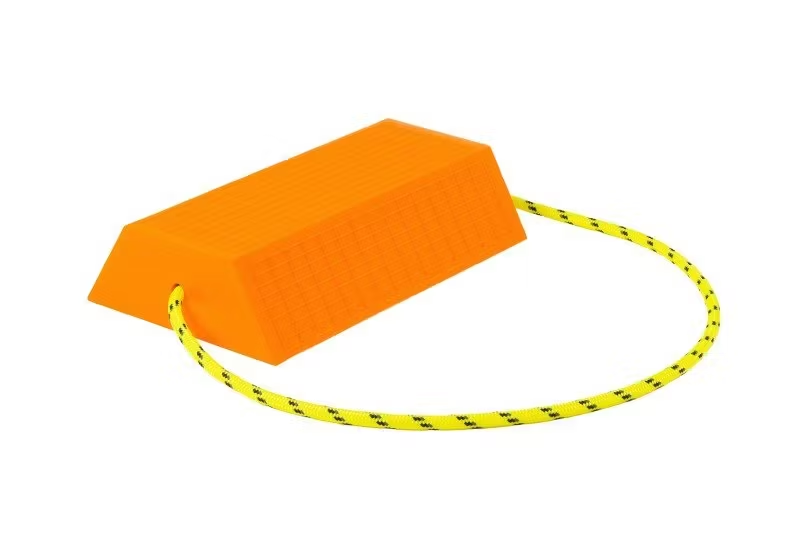Aircraft Chocks and Why You Need Them
Rosén Innovation COM |11/07, 2023

Aircraft Chocks and Why You Need Them
Introduction
When it comes to aircraft safety on the ground, one essential tool that cannot be overlooked is aircraft chocks. These seemingly simple devices play a crucial role in preventing aircraft movement and ensuring the safety of personnel and equipment. In this comprehensive guide, we will explore the importance of aircraft chocks, their various types, and why they are an indispensable part of aviation operations.
The Basics of Aircraft Chocks
Aircraft chocks are wedge-shaped devices made from durable materials such as rubber, plastic, or metal. They are specifically designed to prevent aircraft from rolling or moving unintentionally when parked on the ground. These chocks are placed in front of and behind the aircraft wheels to immobilize them effectively.
The Importance of Aircraft Chocks
Ensuring Aircraft Stability
Aircraft chocks are essential for maintaining aircraft stability while on the ground. They prevent unintended movement caused by external factors such as wind, uneven ground, or inadvertent throttle input. By securing the wheels in place, chocks provide stability and prevent the aircraft from rolling or tipping over.
Ensuring Personnel Safety
Safety is paramount in the aviation industry, and aircraft chocks contribute significantly to it. When aircraft are stationary, chocks act as a physical barrier that prevents them from moving unexpectedly. This ensures the safety of ground crew, maintenance personnel, and passengers who may be present near the aircraft.
Preventing Equipment Damage
Uncontrolled aircraft movement can result in costly damage to equipment and infrastructure. Aircraft chocks act as a reliable safety measure, preventing accidents that could lead to collisions, damage to nearby aircraft, or impact with ground equipment. By using chocks, the risk of costly repairs and downtime is significantly reduced.
Regulatory Compliance
Aircraft operations are subject to various regulations and safety standards. Many aviation authorities and regulatory bodies require the use of aircraft chocks to comply with safety regulations. Adhering to these guidelines is crucial for airlines, airports, and other aviation stakeholders to maintain a high level of safety and avoid penalties or legal issues.
Frequently Asked Questions
Q: Are aircraft chocks necessary for all types of aircraft?
A: Yes, aircraft chocks are necessary for all types of aircraft. Whether it's a small general aviation aircraft or a large commercial airliner, chocks are essential to prevent unintended movement and ensure safety.
Q: Can I use any type of chock for my aircraft?
A: It is recommended to use chocks that are specifically designed for your aircraft type. Different aircraft have different wheel sizes and weight distributions, so using the appropriate chocks ensures proper immobilization.
Q: How should aircraft chocks be positioned?
A: Aircraft chocks should be positioned snugly against the aircraft wheels, both in front of and behind them. This provides the most effective immobilization and prevents any potential movement.
Q: Can chocks be used on sloped surfaces?
A: Yes, chocks can be used on sloped surfaces. However, it is important to choose chocks that have appropriate grip and stability to ensure they don't slip or become dislodged on uneven terrain.
Q: Do aircraft chocks require regular maintenance?
A: While aircraft chocks are relatively low-maintenance, regular inspections are recommended to ensure they are in good condition. Any signs of wear, damage, or degradation should be addressed promptly, and chocks should be replaced if necessary.
Q: Can aircraft chocks be used in conjunction with other safety measures?
A: Yes, aircraft chocks can be used in conjunction with other safety measures such as wheel chocks, parking brakes, and tie-downs. These additional measures provide extra layers of security and stability.
Conclusion
Aircraft chocks are an integral part of aviation safety, providing stability, preventing unintended movement, and ensuring the well-being of personnel and equipment. By understanding their importance and using them correctly, aviation professionals can mitigate risks and uphold the highest standards of safety in aircraft operations. So, next time you see an aircraft securely parked on the ground, remember that the humble aircraft chocks played a vital role in keeping it safely in place.
